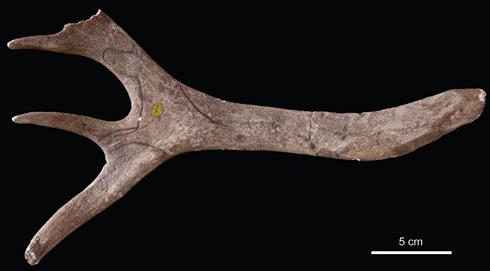Lost and found, the first find of an early human artwork
Natural History Museum
Source - http://phys.org/news/2013-03-lost-early-human-artwork.html#jCp

This reindeer antler from Neschers in France is engraved with a stylised horse. It was created by early humans and found between 1830 and 1848.
A 14,000-year-old engraved reindeer antler is possibly the first piece of early human art ever found. The specimen was uncovered in the 1800s and has been in the vast collections of the Natural History Museum. Its scientific importance, and clues as to how it was made are only now being revealed, scientists report today.
Natural History Museum scientists have pieced together the antler's history. It was found between 1830 and 1848 in Neschers, France, by local village priest Jean-Baptiste Croizet. There are no known records of early human artwork finds before this time and so it is the first, or one of the first, discoveries of Stone Age portable art.
Early humans and art
The engraving shows part of a figure of a horse, and was made by stone age people (modern humans) towards the end of the last ice age. Although these people were hunter-gatherers, living before agriculture and domestication of animals had begun, they were nevertheless skilled technicians and artists.
In the 1800s very little was known about the early history of humans, especially the fact that our species had been around for many hundreds of thousands of years, along with relatives such as the Neanderthals. So the significance of discoveries like the Neschers antler largely went unrecognised at the time.
Since the late 1800s many other carved objects, along with painted caves, have been discovered that show evidence of the art which early humans were creating. The oldest examples of representational art found so far are ivory figurines of animals and humans from early Aurignacian (Upper Palaeolithic) sites in Germany, dated at 35-40,000 years.
Lost and found at the Museum
The Neschers antler at the Museum is a story of lost and found. It was acquired by the Natural History Museum (then the British Museum) in 1848 as part of a larger collection for £440, which at today's value would be about £25,500. In 1881, the Museum became independent from the British Museum and the antler was moved to the new building in South Kensington.
A year later the antler was put on display and mentioned in a Museum gallery guide, but its scientific importance was not recognised. It was eventually returned to the storerooms and all but forgotten until 1989 when it was rediscovered by mammal curator Andy Currant and placed in secure storage.
Despite this, it again remained unstudied and forgotten until an audit of possible worked bone and antler in the fossil collections began in 2010-2011. This was when its scientific importance became apparent and finally, over 160 years after its discovery, a full scientific description is now being published.
Museum human origins expert Prof Chris Stringer, part of the research team says, 'The remarkable story of this forgotten specimen shows how careful study and detective work can belatedly give an important relic the significance it deserves'.
Scanning the antler
Another study by Museum scientists using a micro-CT scanner and 3D microscopy has revealed even more about the Neschers antler.
Results show evidence that the antler had been prepared before being carved. The team could see how its creator had made an incision and then repeatedly scratched it to enlarge the engraving.
They could also tell that the outline of the horse's body and head was scratched out first, and then anatomical features added afterwards. These methods of study are non-destructive and could even be used to identify one ancient artist's work from another.
Museum human evolution researcher Dr Silvia Bello, lead author on both studies says, 'The use of micro 3-Dimensional technologies allows for a more objective evaluation of the metrical characteristics of an engraving, thus facilitating the quantification, rather than the mere description, of the technical procedure adopted.
'Moreover, archaeological digital data have the potential to enable the long-term conservation of an archaeological record and to share these data for cultural, educational and professional purposes.'
The Lost and found paper is published in the Journal of Antiquity and the antler 3D and micro-CT scanning is published in the Journal of Archaeological Science.
More information: Lost and found paper in the Journal of Antiquity Antler art scanning paper in Journal of Archaeological Science